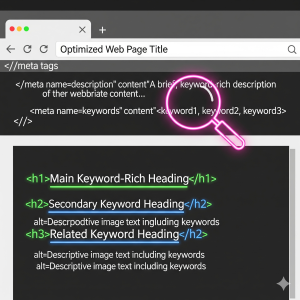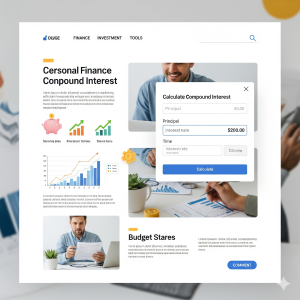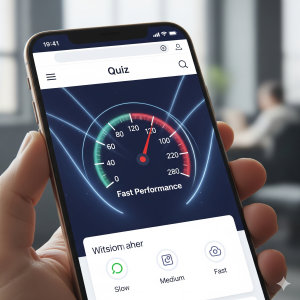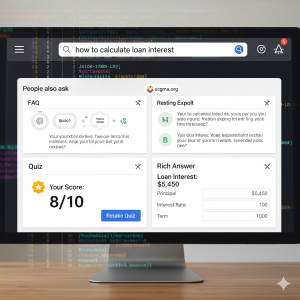Introduction

Interactive content means digital experiences that go beyond plain text and images. Examples include quizzes, polls, calculators, interactive infographics, surveys, and AR/VR demos. Unlike traditional content, interactive content actively involves users and encourages them to participate. This makes it a strong marketing tool because it drives higher engagement, increases time spent on the site, improves brand recall, and generates more backlinks from people who find it useful or fun to share. From an SEO perspective, interactive content not only engages audiences but also signals to search engines that your website provides real value, which can lead to better rankings.
1. Understand the SEO Benefits of Interactive Content

Interactive content offers several SEO benefits that justify the investment. It increases the time users spend on a page, helping to lower bounce rates, which is a good sign for rankings. It also raises the chances of being shared on social media, attracting more backlinks to your site. Additionally, it allows you to gather valuable user data and insights that you can use for future content strategies. When you combine interactive content with static, keyword-rich material, it boosts your topical authority and positions your brand as a trusted source in your industry.
2. Choose the Right Type of Interactive Content

Not all interactive content serves the same goal, so picking the right type is important. Quizzes and polls are great for lead generation and engaging users with personalized results. Calculators and tools, like ROI calculators or budget estimators, provide practical value that keeps visitors returning. Interactive infographics present complex data in clickable and appealing formats. Surveys and forms encourage participation while giving you direct feedback from your audience. For deeper engagement, interactive videos or AR/VR experiences let users immerse themselves in unique storytelling.
3. Optimize Metadata & On-Page SEO

Even the most captivating interactive content won’t work well if it isn’t optimized for search engines. Be sure to create SEO-friendly titles and meta descriptions that showcase the content’s value. Use keyword-rich headings, even for pages dedicated to interactive tools or visuals, so that Google can grasp the context. Don’t forget about accessibility—include alt text for visuals in infographics or graphics and provide clear captions for all interactive elements. These optimizations help your content be user-friendly and search-engine-friendly.
4. Pair Interactive Content with Strong Written Content

A common mistake marketers make is relying only on the interactive element without backing it up with written content. For instance, if you offer an SEO ROI calculator, don’t just embed it on a blank page. Surround it with a detailed blog post of around 1,000 words explaining ROI, its benefits, and how businesses can understand the calculator results. This mix gives Google enough content to crawl while providing users with full context, improving both SEO performance and user experience.
5. Optimize for Speed & Mobile

Fast-loading, mobile-friendly interactive content is essential. Heavy scripts or unoptimized graphics can slow down load times, harming rankings and user satisfaction. To avoid this, use lightweight scripts and ensure animations are compressed. Always test your interactive elements on multiple devices, especially mobile, since most users browse on smartphones. Focusing on speed and mobile responsiveness guarantees your content provides a smooth experience for all users while maintaining good SEO.
6. Add Schema Markup for Rich Results

Schema markup helps Google better understand and display your interactive content. If your content answers questions, use FAQ schema so that your results can show up in featured snippets. For quizzes and assessments, Quiz schema provides structured data that enhances discoverability. Calculators and similar tools can also be marked up so Google can highlight them in search results. Implementing schema boosts your chances of earning rich snippets, which can significantly improve click-through rates.
7. Encourage Sharing & Backlinks

For interactive content to reach its full potential, encourage sharing and backlinks. Adding social sharing buttons within the interactive tool makes it easy for users to spread the word. Providing an embed code for infographics or calculators allows other websites to use your content while linking back to you. Additionally, reaching out to industry blogs or influencers can help secure features that broaden your reach and credibility. The more sharing your interactive content receives, the greater its SEO impact.
8. Track & Measure Performance

Optimization doesn’t stop once you publish—you need to track performance to measure SEO impact. Use tools like Google Analytics (GA4) to check engagement metrics such as time on page, clicks, and completion rates. Assess whether your content is increasing organic traffic and boosting keyword rankings. Beyond SEO, monitor conversion rates to see how many users take action after interacting with the content. Tracking these metrics will help you refine your strategy and maximize long-term results.
Conclusion

Interactive content isn’t just about adding fun features to your website—it’s a strategic tool that can transform your SEO results. By combining creativity with proven SEO techniques such as keyword optimization, schema markup, backlinks, and mobile responsiveness, you can improve your rankings while keeping users engaged. Start small with a simple quiz or calculator, optimize it well, and see how it enhances both traffic and engagement. Over time, interactive content can become one of the most effective ways to increase visibility, credibility, and conversions for your brand.